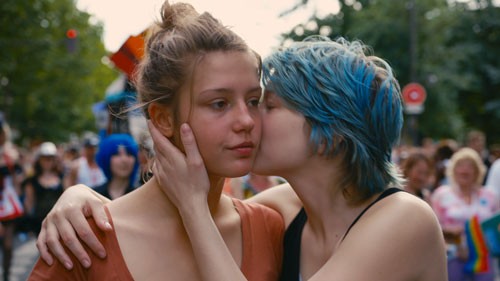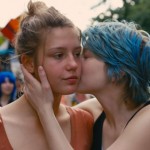Though Blue is the Warmest Color, winner of the Palme d’Or at the 2013 Cannes Film Festival, contains graphic depictions of sex, it is not a voyeuristic exercise but a complex, deeply intense film that elevates one young woman’s personal struggle into a drama of universal relevance. Adapted by Kechiche and Ghalia Lacroix from the novel by Julie Maroh, Tunisian born French director Abdellatif Kechiche’s fifth feature looks with piercing eyes into the coming-of-age years of Adèle (Adèle Exarchopoulos), and her relationship with the more mature Emma (Léa Seydoux), a relationship that does not fit anyone’s pictures.
First seen as a 15-year-old teenager, Adèle’s growing pains are magnified by her attraction to women and she is forced to defend herself against the bullying accusations of her high-school classmates, even though she is confused and uncertain about her identity. Adèle’s face radiates an attractive childlike innocence and openness that is appealing to both sexes and she does not want for friends, but her first relationship with fellow student Thomas (Jérémie Laheurte) does not get off the ground. Her feelings about Thomas seem to answer the question asked by a teacher lecturing on Pierre de Marivaux’s novel La Vie de Marianne, “How do you understand that the heart is missing something?”
After being attracted to a striking looking woman with blue-tinged hair passing by on the street, Adèle meets Emma at a gay bar, learning that she is an aspiring artist and an individual of uncommon intellectual tastes. The chance encounter leads to a relationship and the depiction of an explicit sex scene that is notable for its believability and the raw emotions that are expressed but has, unfortunately, become a source of finger pointing in some quarters. Although the chemistry between the two lovers is unmistakable, Kechiche makes sure that we notice how different their backgrounds are, displaying contrasting scenes at the home of both parents.
Their relationship is openly accepted by Emma’s bohemian parents who persuade Adèle to eat oysters and drink white wine, though seafood is the one type of food she had said she dislikes. In contrast, the nature of their liaison is never brought up at Adèle’s more working-class home where they eat spaghetti and drink red wine. The passage of time is seamless and we have to catch up to the fact that three years have gone by. Adèle, now 18, has moved in with Emma and has fulfilled her ambition to teach young children, while both families seem to have disappeared into the woodwork.
After the first blush of sexual ecstasy has run its course, however, their incompatibility surfaces and is painfully present at a dinner party of Emma’s friends when Adèle has to play the role of servant and gets an uncomfortable feeling about Emma’s attraction to another woman. Eventually, their social and cultural differences get in the way and jealousy and feelings of betrayal begin to replace mutual satisfaction. Blue is the Warmest Color is unique in its openness and honesty about same-sex relationships although we never really experience the outsider status in society and emotional toll that such relationships normally bring. The performances, however, are so perfect that we are never conscious of anything except the beauty of two human beings discovering the joys of authentic intimacy and a connection that can keep providing enough emotional richness to last a lifetime.






'Movie Review: Blue is the Warmest Color (2013)' have 4 comments
November 12, 2013 @ 10:52 pm Elkton
Young. French. Lesbians. Point the way.
November 13, 2013 @ 1:21 am Licensed Contractor
3 hours? Damn, that’s an unbearably long time to sit through between lesbo scenes.
November 22, 2013 @ 3:11 pm Howard Schumann
If you want pornography, there is plenty available.
January 20, 2014 @ 3:00 am Alex Thomas
Glad you loved it as much as me!
I hadn’t seen that poster too, cool. Nice review.